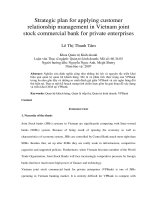Service quality and customer service performance the case of vietnam joint stock commercial bank for private enterprises
Bạn đang xem bản rút gọn của tài liệu. Xem và tải ngay bản đầy đủ của tài liệu tại đây (781.64 KB, 91 trang )
vietnam national university, HANOI
school of business
Nguyen Quynh Trang
Service quality and customer service
performance – The case of vietnam joint stock
commercial bank for private enterprises
Major: Business Administration
Code: 60 34 05
Master of business administration thesis
Supervisors:
1. Dr.PHAM THI NHUAN
2. DANG NGOC SU, MBA
Hanoi – 2007
TABLE OF CON
ACKNOWLEDGEMENTS................................................................................................
ABSTRACT........................................................................................................................
TÓM TẮT
.................................
TABLE OF CONTENTS....................................................................................................
LIST OF ABBREVIATIONS..............................................................................................
LIST OF FIGURES ...........................................................................................................
LIST OF TABLES..............................................................................................................
INTRODUCTION ..............................................................................................................
1.
Rationale .............................................................................................................
2.
Objectives & aims..............................................................................................
3.
Hypotheses.........................................................................................................
4.
Scope of work .....................................................................................................
5.
Data resource & processing ................................................................................
6.
Methods & approaches .......................................................................................
7.
Significance ........................................................................................................
8.
Limitations ..........................................................................................................
9.
Expected results ..................................................................................................
10.
Follow –up (potential) ........................................................................................
11.
Thesis structure .................................................................................................
PART 1: LITERATURE REVIEW AND RESEARCH METHODOLOGY ....................
CHAPTER 1: LITERATURE REVIEW............................................................................
1.1 The nature of services and Characteristics of services .................................................
1.1.1Why study services?
1.1.2What is service? .....
1.1.3Characteristics of se
1.2 Managing service quality..............................................................................................
1.2.1Service quality.........
1.2.2Dimensions of servic
1.2.2.1 Reliability ..............................................................................................
1.2.2.2 Empathy..................................................................................................
1.2.2.3 Assurance...............................................................................................
1.2.2.4 Responsiveness.......................................................................................
1.2.2.5 Tangibles ...............................................................................................
1.2.3Results of previous r
1.2.4The effect of employ
1.3 Measure of customer service performance ...................................................................
CHAPTER 2: RESEARCH METHODOLOGY ................................................................
2.1 Study Design.................................................................................................................
2.2 Measures .......................................................................................................................
2.3 Sampling ......................................................................................................................
2.4 Data collection .............................................................................................................
2.4.1Method of data colle
2.4.2Questionnaire design
2.4.3Questionnaire pretes
2.4.4Respond rate ..........
2.4.5Procedure of Purific
2.4.5.1 Procedure of purification and validation ...............................................
2.4.5.2 Procedure of reliability .........................................................................
2.5 Summary ......................................................................................................................
PART 2. STATUS OF VPBANK AND DATA ANALYSIS ...........................................
CHAPTER 3: STATUS OF VPBANK ..............................................................................
3.1
General overview of VPBank ...........................................................................
3.1.1Vision and Mission
3.1.2Core value and Bus
3.2
Foundation and development process ...............................................................
3.3
Organization structure .......................................................................................
3.4
Employees and Training Programs....................................................................
3.5
Products & Services...........................................................................................
3.6
Business operation results in 2006 ....................................................................
3.7
Achievements.....................................................................................................
3.8
Orientation of business activities for 2007 .........................................................
CHAPTER 4: DATA ANALYSIS ....................................................................................
4.1
Descriptive statistics .........................................................................................
4.1.1Demographics of th
4.1.2Descriptive statistic
4.1.2.1 Descriptive statistics for five dimensions..............................................
4.1.2.2 Descriptive statistics of customer satisfaction ......................................
4.2
Reliability Test ..................................................................................................
4.3
Factor analysis ....................................................................................................
4.3.1Factor analysis for
4.3.2Factor analysis for
4.3.3Factor analysis for
4.3.4Factor analysis for
4.3.5Factor analysis for
4.4
Analysis of Relationships .................................................................................
4.4.1Scatter grams ........
4.4.2Collinearity problem
4.4.3Multiple regression
4.4.4Hypotheses Test ....
4.5 Summary ......................................................................................................................
PART 3: CONCLUSION AND RECOMMENDATIONS ...............................................
CONCLUSION...................................................................................................................
RECOMMENDATIONS....................................................................................................
REFERENCES ..................................................................................................................
APPENDICES
LIST OF ABBREVIATIONS
VPBank: Vietnam Joint Stock Commercial Bank for Private Enterprises
CJS Bank: Commercial Joint- Stock Bank
CA's: Cronbach's Alpha
VIF: Variance inflation factor
CS: Customer satisfaction
LIST OF FIGURES
Figure 1.1 Customer Perceptions of Quality and Customer Satisfaction
…………..12
Figure 3.1 VPBank's Organization Chart........................................................................................ 25
Figure 3.2 Safety assurance ratios..................................................................................................... 27
Figure 3.3 mobilized Capital source................................................................................................. 27
Figure 3.4 Structure of outstanding loans....................................................................................... 28
Figure 4.1 Scree Plot of Reliability.................................................................................................. 40
Figure 4.2 Scree Plot of Empathy..................................................................................................... 42
Figure 4.3 Scree Plot of Tangible...................................................................................................... 44
Figure 4.4 Scree Plot of Responsiveness........................................................................................ 46
Figure 4.5 Scree Plot of Assurance................................................................................................... 48
LIST OF TABLES
Table: 2.1 Measurement of five dimensions of service quality..........................................
Table 2.2 Measurement of Bank's Performance .................................................................
Table 4.1 Demographic Descriptive Statistics....................................................................
Table 4.2 Descriptive Statistics for Reliability...................................................................
Table 4.3 Descriptive Statistics for Empathy .....................................................................
Table 4.4 Descriptive Statistics for Tangible .....................................................................
Table 4.5 Descriptive Statistics for Responsiveness ..........................................................
Table 4.6 Descriptive Statistics for Assurance ...................................................................
Table 4.7 Description Statistics of Customers' Satisfaction ...............................................
Table 4.8 Reliability Statistics............................................................................................
Table 4.9 Total Variance Explained - Reliability...............................................................
Table 4.10 Factor solution for Reliability...........................................................................
Table 4.11The Total Variance Explained - Empathy .........................................................
Table 4.12 Factor solution for Empathy .............................................................................
Table 4.13 Total Variance Explained - Tangible................................................................
Table 4.14 Factor solution for Tangible .............................................................................
Table 4.15 Total Variance Explained - Responsiveness ....................................................
Table 4.16 Factor solution for Responsiveness ..................................................................
Table 4.17 Total Variance Explained - Assurance .............................................................
Table 4.18 Factor solution for Assurance...........................................................................
Table 4.19 Collinearity Statistics........................................................................................
Table 4.20 Results of Multiple Regressions .......................................................................
Table 4.21 Ranking the importance of dimensions ............................................................
............................................................................................................................................
............................................................................................................................................
APPENDIX
Appendix A: QUESTIONNAIRE................................................................................................ 58
Appendix B: RESULTS OF DATA ANALYSIS.................................................................... 61
INTRODUCTION
1. Rationale
Joining the WTO, the Vietnam banking system has been heavily influenced
by the international financial market in terms of exchange rates, interest rates and
foreign currency reserves, while they must simultaneously carry out international
obligations and commitments. Competition will probably become much stronger
when foreign banks expand their scale and scope of operations in the Vietnamese
market. Vietnamese commercial banks will need to cope with many difficulties in
expanding their banking activities in the world and competing with foreign banks
whose strength of capital, technology, services and global operational scale provide
them with potential advantages.
Before these challenges, Vietnamese commercial banks, especially Joint
Stock Commercial Banks have been giving out many strategies such as widening
branches, interest competitiveness, or promotion campaigns, and so on. However,
all of them recognized that service quality was critical element to attract customers
and necessary for effective competition.
Conscious of this fact, in recent year VPBank has placed great importance on
improving service quality, thus all dimensions of service quality were concerned but
the contribution level of each dimension of service quality has not identified yet.
Therefore, its needs to identify the relative importance of each quality
dimension which impact to customer service performance of VPBank.
2. Objectives & aims
Objectives of study
The objective of this research is to investigate the relationship between five
dimensions of service quality and Customer Service Performance of VPBank.
Aims of study
VPBank's managers can use this instrument as a baseline for a longitudinal
benchmarking program that is a means of comparing its performance from branch to
branch or from year to year.
3. Hypotheses
In this study, five dimensions of service quality including reliability, empathy,
tangible, responsiveness and assurance were employed to evaluate the impacts of
those dimensions on customer service performance of VPBank. A below research
model shows five relationships converted into five hypotheses.
Reliability
Empathy
Tangible
Responsiveness
Assurance
Hypotheses 1: A positive relationship exits between Reliability and Customer
Service Performance of VPBank - Hanoi branch.
Hypotheses 2: A positive relationship exits between Empathy and Customer Service
Performance of VPBank- Hanoi branch.
Hypotheses 3: A positive relationship exits between Tangible and Customer Service
Performance of VPBank- Hanoi branch.
Hypotheses 4: A positive relationship exits between Responsiveness and Customer
Service Performance of VPBank- Hanoi branch.
Hypotheses 5: A positive relationship exits between Assurance and Customer
Service Performance of VPBank- Hanoi branch.
4. Scope of work
This study focuses only on identifying the relative importance of five dimensions of
service quality on customer service performance of VPBank Hanoi branch. The
target customers are retail customers of VPBank. Because of the time and resources
limitation to survey, this research surveys at VPBank Hanoi branch.
5. Data resource & processing
Data resource
In view of the research's nature and in order to ensure the reliability of the
findings, it becomes necessary to collect data from primary source. A survey was
therefore
undertaken
through
hand-
distributed
questionnaire
technique.
Questionnaires were personally delivered to and collected from customers came
VPBank to implement transactions during the period of survey.
Data Processing
After collecting the raw data, these data must be transformed into
information that will answer the manager's question. The conversion of raw data
into information requires that the data was edited and coded so the data may be
transferred to a computer and SPSS software version 13.0 for Windows was used to
analyze data. Each possible response to each question in the questionnaire was
coded in the ways that conform to the requirements of this program. After the data
was coded, the data were then ready to be analyzed.
6. Methods & approaches
This study used quantitative method to collect information about the
perceived personality through a questionnaire. All responses in questionnaire
expressed in numbers analyzed quantitative.
7. Significance
For theoretical significance: The research enhances understanding of how five
dimensions of service quality with customer satisfaction were. In addition, it adds to
the knowledge of services marketing and research marketing.
For empirical significance: This is the first empirical study to date in VPBank to
examine the relationships between five dimensions of service quality and customer
service performance of VPBank at Hanoi branch. VPBank's managers can use this
instrument as a baseline for a longitudinal benchmarking program. Having a
baseline will give VPBank's management a means of comparing its performance
from branch to branch or from year to year. Moreover, VPBank managers can use
the data to determine if they are performing well or poorly in the specific aspects of
the service experience. It is much easier to improve services if management knows
what needs to be improved. Having this information will help managers allocate
funds or resources towards areas that most need improvement.
8. Limitations
Like other researches, this study has also several limitations. Because the
scope of this research focuses only on individual customer group of VPBank, and
survey test only VPBank Hanoi branch. Moreover, this study is also limited both
time and resources.
9. Expected results
The result of this study showed positive effects for reliability, empathy,
tangible, responsiveness and assurance on customer service performance.
Regression analysis has been applied to identify the relative importance of the
quality dimensions. Standardized beta coefficients are the parameters used to
determine the contribution of each dimension. The higher the score is , the more
important the dimension is.
10. Follow –up (potential)
The finding reported in this study offer several suggestions for future
research. In future, researcher can cover more service categories and with large
database to identify more dimensions to add to the service quality construct such as
technology.
11. Thesis structure
Excluding the executive summary, introduction, references and appendixes, this
thesis contains three parts
The first part, named, "Literature review and research design" covers
chapters one and two. The purpose of this part is to introduce the theoretical
background and the design of the study. All relevant theories: service and
characteristics of service, managing service quality, and customer satisfaction were
contained in chapter 1. Chapter 2 presented methodological issues such as providing
an explanation of the measurement, sampling method, data collection, and
procedure of purification, validity, and reliability.
The second part of this study, named, "Status of VPBank and Data analysis"
contains chapters three and four. The purpose of this part is to introduce general
information about VPBank in chapter 3 and chapter 4: Data analysis presented
discussion of the study's finding.
Finally, part three, titled "Recommendations and Conclusion" will review the
findings and give recommendations for the findings.
PART 1: LITERATURE REVIEW AND RESEARCH
METHODOLOGY
CHAPTER 1: LITERATURE REVIEW
1.1 The nature of services and Characteristics of services
1.1.1 Why study services?
Modern economies are driven by service businesses, both large and small.
Services are responsible for the creation of a substantial majority of new jobs, both
skilled and unskilled, around the world. The service sector includes a tremendous
variety of different industries, including many activities provided by public and
nonprofit organizations. It accounts for over half the economy in most developing
countries and for over 70 percent in many highly developed economies (C.
Lovelock & L.Wright).
1.1.2 What is service?
A service is an act or performance offered by one party to another. Although
the process may be tied to a physical product, the performance is essentially
intangible and does not normally result in ownership of any of the factors of
production.
Services are economic activities that create value and provide benefits for
customers at specific times and places, as a result of bringing about a desired change
in - or on behalf of - the recipient of the service.
1.1.3 Characteristics of services
Services have six characteristics: intangibility, heterogeneity, simultaneity, perish
ability, transferability and cultural specificity (Anonymous, 1998).
Intangibility: Intangibility is a key determinant of whether an offering is or is
not service. Intangibility makes services more difficult for customers to imagine and
desire than goods. Because of intangible characteristic, services can not be
inventoried, patented, readily displayed or communicated, and service price is
difficult.
Heterogeneity: Services are frequently delivered by human beings to human
beings. However, humans tend to be inconsistent in their behavior, their delivery
and consumption of services. Thus, the heterogeneity connected with services is
largely the result of human interaction between and among employees and
customers. Because of heterogeneous characteristics, service delivery and customer
satisfaction depend on employee actions. Service quality depends on many
uncontrollable factors, and there is no sure knowledge that the service delivered
matches what was planned and prompted.
Simultaneity: Most services are produced and consumed at the same time.
Customers participate in and affect the transaction, customers affect each other,
employees affect the service outcome, decentralization may be essential, and mass
production is difficult.
Perishability: Perishability refers to the fact that services cannot be saved,
stored resold, or returned. Therefore, it is difficult to synchronize supply and
demand with services, and inability to inventory.
Transferalbility: The transferalbility means that different services operations
may share common components/ characteristics. In the fact, the types and sources
of expectations are the same for end consumers and business customers, for pure
service and product-related service, and for experienced customers and
inexperienced customers. The transferalbility implies that it is important to monitor
new developments not only in our industry, but also in other service industries
because many lessons can be learned from other service industries.
Cultural Specificity: The cultural context in which a service is consumed can
be viewed as an attribute of the service itself. Cultural specificity affects the ways
customers evaluate and use services. It also influences the way companies and their
service employees interact with customers.
1.2 Managing service quality
1.2.1 Service quality
Quality Service is the customers’ subjective assessment that the service they
are receiving is the service that they expect (Parasuraman, et al. 1985, Watson, et al.
1998). Service quality is commonly identified as being one of the most effective - if
difficult - means of building a competitive position in a service industry and
improving organizational performance (Lewis, 1993).
Service quality impacts on satisfaction directly (Kandampully et al., 2001).
According to Oliver (1997), higher levels of quality will result in greater customer
satisfaction and loyalty, and thus improved profits.
1.2.2 Dimensions of service quality
The dimensions of service quality have been identified through the
pioneering research of Parsu Parasuraman, Valarie Zeithaml, and Leonard Berry.
Their researches identified five specific dimensions of service quality that apply
across a variety of service contexts.(Zeithaml, et al. 1996) . These dimensions
represent how consumers organize information about service quality in their minds.
These dimensions include : (1) Reliability, the belief that the service provider is
providing service in a reliable and dependable manner; (2) Empathy, meaning
individualized attention; (3) Tangibles, an appealing physical environment; (4)
Responsiveness, the perceived willingness of the service provider to help its
customers; and (5) Assurance, instilled confidence through courtesy and ability.
1.2.2.1. Reliability
Reliability is defined as the ability to perform the promised service
dependably and accurately. In its broadest sense, reliability means that delivers on
its promises - promises about delivery, service provision, problem resolution and
pricing. Customers want to do business with companies that keep their promises,
particularly their promises about the service outcome and service attributes. All
firms need to be aware of customer expectations of reliability Firms that do not
provide the core service that customer think they are buying fail their customers in
the most direct way.
1.2.2.2 Empathy
Empathy is defined as the caring, individualized attention that the firm
provides its customers. The essence of empathy is conveying through personalized
or customized service that customers are unique, special, and that their needs are
understood. Customers want to feel understood by and important to firms that
provide service to them. Personnel at small service firms often know customers by
name and built relationships that reflect their personal knowledge of customer
requirements and preferences. When such a small firm competes with larger firms,
the ability to be empathetic may give the small firm a clear advantage.
1.2.2.3 Assurance
Assurance is defined as employees’ knowledge, courtesy, and the ability of
the firm and its employees to inspire trust and confidence.
Trust and confidence may be embodied in the person link the customer to the
company, such as securities brokers, insurance agents, lawyers, or counselors. In
such service contexts, the companies seek to build trust and loyalty between key
contact people and individual customers. The "personal banker" concept captures
this idea: customers are assigned to a banker who will get to know them
individually and who will coordinate all their banking services.
1.2.2.4 Responsiveness
Responsiveness is willing to help customers and to provide prompt service.
This dimension emphasizes attentiveness and promptness in dealing with customer
requests, questions, complaints and problems. Responsiveness is communicated to
customer by the length of time they have to wait for assistance, answers to
questions, or attention to problems. Responsiveness also captures the notion of
flexibility and ability to customize the service to customer needs.
1.2.2.5 Tangibles:
Tangibles are defined as the appearance of physical facilities, equipment,
personnel and communication materials. Tangibles provide physical representations,
or image of the service that customer, particularly new customers, will use to
evaluate quality.
Although tangible are often used by service companies to enhance their
image, provide continuity, and signal quality to customers, most companies combine
tangibles with another dimension to create a service quality strategy for the firm. In
contrast, firms that do not pay attention to the tangibles dimension of the service
strategy can confuse and even destroy an otherwise good strategy.
1.2.3 Results of previous researches
According to the authors of Principle of Service Marketing and Management,
C.Lovelock & L.Wright, of these five dimensions, reliability has consistently
proven to be the most important factor in customers' judgments of service quality.
Reliability improvements lie at the heart of service quality enhancement efforts
because unreliable service implies broken promises on the attributes that customers
care about. If the core service is not performed reliably, customers may assume that
the company is incompetent and may switch to another service provider
(C.Lovelock & L.Wright, p267).
Reliability is an outcome measure because customers judge it after the
service experience: Either the service was delivered as promised or it wasn'
(C.Lovelock & L.Wright, p268).
The other four dimensions of quality—tangibles (physical evidence),
responsiveness, assurance, and empathy—are process dimensions because they can
be evaluated by customers during service delivery. These dimensions provide
companies with the opportunity to delight customers by exceeding their
expectations during interactions with employees and the service environment
(C.Lovelock & L.Wright, p268).
According to C.Lovelock & L.Wright also, a recent study, based on data
collected from focus group interviews, explored the criteria customers use to assess
electronic service quality (e-SQ). The results indicate that some of the quality
dimensions of service quality (reliability, responsiveness) are important in both
online and offline settings. Survey results indicate that poor service quality is the
reason that most people leave Web sites. Source: Mary B. Young, "What Customers
Want Online," Insights from MSI (Cambridge, MA: Marketing Science Institute,
Fall 2000), 5-6; Valarie A. ZeithamI, A. Parasuraman, and ArvindMalhotra, "A
Conceptual Framework for Understanding e-Service Quality: Implications for
Future Research and Managerial Practice" (Cambridge MA: Marketing Science
Institute, 2001).
1.2.4 The effect of employee behaviors on service quality dimensions
According to Zeithaml, Bitner & Gramler, all of five dimensions of service
quality can be influenced directly by service employees. Delivering the service as
promised - reliability- is often totally within the control of frontline employees.
Frontline employees directly influence customer perceptions of responsiveness
through their personal willingness to help and their promptness in serving
customers. The assurance dimension of service quality is highly depending on
employees' ability to communicate their credibility and to inspire trust and
confidence. Empathy implies that employees will pay attention, listen, adapt, and be
flexible in delivering what individual customer need. Employee appearance and
dress are important aspects of the tangible dimension of quality.
1.3 Measure of customer service performance
According to Zeithaml & Bitner, 2000, there are number of dimensions of
firm performance divided into two categories: financial accounting indicators (such
as: return on assets, return on sale, return on equity and non-financial indicators
(such as: market share, quality, innovation, human resources, and customer
satisfaction)... This research chose the customer satisfaction represented for
measurement of customer service performance.
What is Customer Satisfaction?
The consumer satisfaction is a central concept in marketing, in the practices of the
companies, as well as in the field of the theory of the consumer behavior (Evrard,
1993). Satisfaction is customer's evaluation of a product or service in terms of
whether that product or service has met the customer's needs and expectations.
(Zeithaml, Bitner & Gramler, 2006)
What Determines Customer Satisfaction?
According to Zeithaml, Bitner & Gramler, customer satisfaction is influenced by
specific product or service feature, perception of product and service quality, and
price. In addition, personal factors such as the customer's mood or emotional state
and situational factors such as family member opinions will influence satisfaction
This study chose perception of service quality to measure customer satisfaction.
Perception is the process you use to select, organize, and interpret information in a
way that provides you a meaningful picture of the world. The way a customer
perceives a situation will have an important influence on how they go about
satisfying their needs. The figure 1.1 showed the factors influenced on customer
satisfaction.
Reliability
Responsiveness
Assurance
Empathy
Tangible
Figure 1.1 Customer Perceptions of Quality and Customer Satisfaction
Customer satisfaction is the means to achieve key business goals
According to C. Lovelock & L.Wright, p.78, customer satisfaction is not an end in
itself. Instead, it is the means to achieving key business goals.
First, satisfaction is inextricably linked to customer loyalty and relationship
commitment.
Second, highly satisfied (delighted) customers spread positive word-of
mouth. They become walking, talking advertisements for an organization whose
service has pleased them, and thus lowering the cost of attracting new customers.
Third, highly satisfied customers may be more forgiving. Someone who has
enjoyed good service delivery many times in the past is more likely to believe that a
service failure is a deviation from the norm. It may take more than one unsatisfactory
incident for strongly loyal customers to change their perceptions and consider switching to
an alternative supplier. In this respect, high levels of customer satisfaction act like an
insurance policy against the impact of a single failure.
Finally, delighted customers are less susceptible to competitive offerings than
customers who are simply satisfied or are unhappy with their current service provider.
CHAPTER 2: RESEARCH METHODOLOGY
2.1 Study Design
The aim of design is to find out popularity of a phenomenon, situation,
problem, attitude or issue by taking a cross section of the population (Kumar, 1999).
A cross - sectional study is extremely simple in design. Researchers decide what
they want to find out, identify the study population, select a sample and contact
respondents to find out the required information (Kumar, 1999).
This study used a quantitative research design. Questionnaire survey was conducted
to collect data from a number of individual customers of VPBank to test five
hypotheses.
2.2 Measures
This section explains measures of independent variables (reliability, empathy,
tangible, responsiveness, assurance) and dependent variable (customer satisfaction).
The survey was composed of two primary scales to measure the customers’
perceptions about service quality on five dimensions, and customer's satisfaction.
The service quality scale asked the respondents to evaluate the performance of
operation on the set of 21 attributes. The one-item satisfaction scale measured the
customers’ overall satisfaction with the services that they receive from the bank.
Both scales used a 5-point Likert scale ranging from 1, very poor, through 5, very
good for and from 1, very dissatisfied, through 5, very dissatisfied for customers'
satisfaction.
Table: 2.1 Measurement of five dimensions of service quality
Dimensions
Reliability
Employees send timely information
Timeliness of service
Documentations are correct
Employees care about resolving problems
Employee is dependable
Empathy
Employees give customer personal attention.
Employees have convenient service features
Employees care customer's best interest.
Employees understand customer's needs.
Tangible
Employees appear neat and tidy
Facilities and equipments are modern and pleasing
Information material visually appealing
Responsiveness
Employees are always willing to help customer.
Employees give you prompt service.
Employees inform customer exactly when services
will be performed.
Employees are never busy too respond to
customers' requests.
Assurance
Employee’s behavior instills trust.
You feel safe in your transactions with employees.
Employees are courteous.
Employees are knowledgeable.









